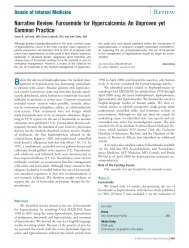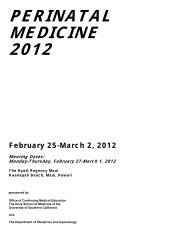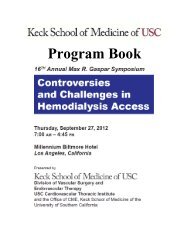i. Data are insufficient to make a recommendation as towhether condom catheterization is preferable to short-term orlong-term indwelling urethral catheterization for reduction <strong>of</strong>CA-UTI.ii. Data are insufficient to make a recommendation as towhether condom catheterization is preferable to short-term orlong-term indwelling urethral catheterization for reduction <strong>of</strong>CA-bacteriuria in those who are cognitively impaired.17. Intermittent catheterization should be considered as analternative to short-term (C-I) or long-term (A-III) indwellingurethral catheterization to reduce CA-bacteriuria <strong>and</strong> an alternativeto short-term (C-III) or long-term (A-III) indwellingurethral catheterization to reduce CA-UTI.18. Suprapubic catheterization may be considered as an alternativeto short-term indwelling urethral catheterization toreduce CA-bacteriuria (B-I) <strong>and</strong> CA-UTI (C-III).i. Data are insufficient to make a recommendation as towhether suprapubic catheterization is preferable to long-termindwelling urethral catheterization for reduction <strong>of</strong> CA-bacteriuriaor CA-UTI.ii. Data are insufficient to make a recommendation as towhether intermittent catheterization is preferable to suprapubiccatheterization for reduction <strong>of</strong> CA-bacteriuria or CA-UTI.Intermittent <strong>Catheter</strong>ization TechniqueRecommendations19. Clean (nonsterile) rather than sterile technique may beconsidered in outpatient (A-III) <strong>and</strong> institutional (B-I) settingswith no difference in risk <strong>of</strong> CA-bacteriuria or CA-UTI.20. Multiple-use catheters may be considered instead <strong>of</strong> sterilesingle-use catheters in outpatient (B-III) <strong>and</strong> institutional(C-I) settings with no difference in risk <strong>of</strong> CA-bacteriuria orCA-UTI.21. Data are insufficient to make a recommendation as towhether one method <strong>of</strong> cleaning multiple-use catheters is superiorto another.22. Hydrophilic catheters are not recommended for routineuse to reduce the risk <strong>of</strong> CA-bacteriuria (B-II) or CA-UTI (B-II).23. Data are insufficient to make recommendations onwhether use <strong>of</strong> portable bladder scanners or “no-touch” techniquereduces the risk <strong>of</strong> CA-UTI, compared with st<strong>and</strong>ardcare.Evidence SummaryAlternatives to indwelling urethral catheterization include intermittentcatheterization, suprapubic catheterization, <strong>and</strong> theuse <strong>of</strong> external collection devices, including condom catheters,diapers or pads.Indications <strong>and</strong> limitations <strong>of</strong> intermittent catheterization.Guttman <strong>and</strong> Frankel [155] in 1966 described intermittentcatheterization using sterile technique in patients with neurogenicbladders. Lapides et al [156] later demonstrated in observationalstudies that the clean (nonsterile) technique wassafe <strong>and</strong> associated with a low incidence <strong>of</strong> complications. Intermittentcatheterization is widely viewed to be associated withfewer complications, compared with indwelling urethral catheterization,including fewer instances <strong>of</strong> CA-bacteriuria, pyelonephritis,epididymitis, periurethral abscess, urethral stricture,vesicoureteral reflux, hydronephrosis, bladder <strong>and</strong> renal calculi,bladder cancer, <strong>and</strong> autonomic dysreflexia [22, 24, 157, 158].In a 38-month prospective observational study involving 128patients with acute spinal cord injuries, the incidence rates per100 person-days for CA-bacteriuria <strong>and</strong> CA-UTI, respectively,were 5 <strong>and</strong> 2.72 cases for men with indwelling urethral catheters(128 patients), 2.95 <strong>and</strong> 0.41 cases for men with clean intermittentcatheterization (124 patients), 2.41 <strong>and</strong> 0.36 cases formen with condom catheters (41 patients), <strong>and</strong> 0.96 <strong>and</strong> 0.34cases for women with suprapubic catheterization (10 patients),respectively [25]. Although there are no r<strong>and</strong>omized, controlledtrials that have compared long-term catheterization methods(intermittent urethral catheterization, indwelling urethral orsuprapubic catheterization, <strong>and</strong> external catheter for men) inmanaging voiding problems in patients with [159] or withoutneurogenic bladders, clean intermittent catheterization has becomethe st<strong>and</strong>ard <strong>of</strong> care for appropriate women <strong>and</strong> menwith spinal cord injuries [16]. In addition, clean intermittentcatheterization is a more commonly used alternative in menwith bladder atonia <strong>and</strong> elderly patients who need assistancewith voiding [21, 77, 160].In contrast to patients with long-term catheterization, patientswith short-term catheterization have been the subject <strong>of</strong>r<strong>and</strong>omized trials <strong>of</strong> catheterization techniques. A recent Cochranereview <strong>of</strong> r<strong>and</strong>omized or quasi-r<strong>and</strong>omized trials thatcompared catheterization methods in patients who underwentshort-term bladder drainage (14 days duration) found 2 trials(both involving patients who underwent surgical procedures)that compared indwelling urethral catheterization with intermittentcatheterization [161]. The meta-analysis showed thatsignificantly more cases <strong>of</strong> CA-bacteriuria occurred in the indwellingurethral catheterization group (RR, 2.90; 95% CI,1.44–5.84).Intermittent catheterization is not commonly used for shorttermcatheterization, however, because <strong>of</strong> the educational, motivational,<strong>and</strong> staff-time requirements necessary for its implementation<strong>and</strong> because <strong>of</strong> discomfort in sensate patients. Otherlimitations to intermittent catheterization include the inabilityor unwillingness <strong>of</strong> patients to perform frequent catheterizationbecause <strong>of</strong> comorbid conditions or discomfort, or abnormalurethral anatomy, such as stricture, false passages, or bladderneck obstruction. Upper extremity impairment because <strong>of</strong> cervicalspinal cord injury or other abnormality, obesity, <strong>and</strong> spas-Downloaded from http://cid.oxfordjournals.org/ by guest on November 29, 2011642 • CID 2010:50 (1 March) • Hooton et al
ticity also make intermittent catheterization challenging forboth male <strong>and</strong> female patients.Techniques used for intermittent catheterization. Thereare many different techniques used in intermittent catheterization,such as sterile or clean technique, use <strong>of</strong> sterile or multiple-usecatheters with the clean technique, whether a multipleusecatheter is changed daily or weekly, <strong>and</strong> use <strong>of</strong> hydrophilicor st<strong>and</strong>ard catheters. The main difference between sterile <strong>and</strong>clean (single-use) technique is that sterile gloves <strong>and</strong> drapes areused for the former but not for the latter technique. Studiesthat compared these techniques among patients managed withintermittent catheterization were evaluated in a recent Cochranereview [162]. The authors found studies to be methodologicallyweak, to have small sample sizes, <strong>and</strong>, in several trials,to combine use <strong>of</strong> catheters <strong>and</strong> <strong>of</strong> techniques leading to possibleconfounding. Nevertheless, the Cochrane authors concludedfrom a meta-analysis <strong>of</strong> these trials involving inpatients<strong>and</strong> outpatients with <strong>and</strong> without neurogenic bladders whoreceived intermittent catheterization that there was no differencein the risk <strong>of</strong> CA-bacteriuria or CA-UTI with use <strong>of</strong> sterileor clean technique, with use <strong>of</strong> sterile catheters (single-use) ormultiple-use catheters using the clean technique, or with use<strong>of</strong> multiple-use catheters changed daily or weekly using theclean technique [160, 163–167]. There are no r<strong>and</strong>omized, controlledstudies that compared clean or sterile technique forintermittently catheterized patients in the outpatient setting,although the clean technique is widely used by outpatients.Although there are no data that indicate that reusing urinarycatheters when performing intermittent catheterization increasesinfection risk, it may be inconvenient for many patientswho find it difficult to clean their catheters away from home,<strong>and</strong> some patients find it unaesthetic.The Cochrane review also evaluated r<strong>and</strong>omized, controlledtrials <strong>of</strong> coated (hydrophilic or prelubricated with water solublegel) or uncoated (separate lubricant) catheters in adults <strong>and</strong>children managed with intermittent catheterization [162]. Hydrophiliccatheters are characterized by having a layer <strong>of</strong> polymercoating that is bound to the catheter surface that absorbs<strong>and</strong> binds water to the catheter, which results in reduced frictionon catheter insertion <strong>and</strong> reduced urethral inflammation [168].These catheters have been associated with improved patientsatisfaction in some [169] but not all [166] studies. A crossovertrial involving men with prostate enlargement showed noreduction in CA-bacteriuria or CA-UTI with the hydrophiliccatheter [166]. Three parallel group trials compared a hydrophiliccatheter with an uncoated catheter <strong>and</strong> reported data onCA-UTI [170–172]. In the largest <strong>of</strong> these 3 studies, a r<strong>and</strong>omizedstudy involving 123 male patients with spinal cordinjury, there were fewer patients with CA-UTI in the hydrophiliccatheter group, compared with the uncoated cathetergroup (39 [64%] <strong>of</strong> 61 vs 51 [82%] <strong>of</strong> 62; RR, 0.78; 95% CI,0.62–0.97) [162, 170]. However, only 57 (46%) <strong>of</strong> the 123subjects completed the 12-month study. The estimates fromthe smaller trials had wide confidence intervals that straddledthe no-difference line [162, 171, 172]. In summary, currentevidence does not support the routine use <strong>of</strong> hydrophilic cathetersto reduce CA-bacteriuria, CA-UTI, or sequelae <strong>of</strong> urethraltrauma in patients managed with intermittent catheterization[162, 173], but further studies are warranted.In patients who undergo intermittent catheterization, ascension<strong>of</strong> bacteria colonizing the urethra into the bladder is morelikely to be the source <strong>of</strong> CA-bacteriuria than is exogenousbacteria colonizing the catheter. Nevertheless, several procedureshave been evaluated <strong>and</strong> have been shown to reducebacterial contamination <strong>of</strong> reusable catheters, including rinsingcatheters with running tap water after every use, air-drying,<strong>and</strong> keeping the catheters dry until reuse [174]; microwavingcatheters [175–178]; <strong>and</strong> soaking catheters in hydrogen peroxide,bleach, or betadine [179]. However, there are no publishedtrials evaluating the effectiveness <strong>of</strong> any <strong>of</strong> these cleaningmethods in preventing CA-bacteriuria or CA-UTI among patientswith intermittent catheterization.In patients who undergo intermittent catheterization, portablebladder scanners accurately assess bladder volumes [180–183]. In addition, studies that compared volume-dependent<strong>and</strong> time-dependent intermittent catheterization with these deviceshave shown the volume-dependent method to reduceincontinence, number <strong>of</strong> catheterizations, <strong>and</strong> cost [184–186].However, the effectiveness <strong>of</strong> these devices in preventing CAbacteriuriaor CA-UTI in patients who undergo intermittentcatheterization has not been reported.Use <strong>of</strong> the “no-touch” technique <strong>of</strong> intermittent catheterization(in which the catheter <strong>and</strong> preattached collecting systemare not touched by the patient) reduces microbial contamination<strong>of</strong> the catheter [187]. Although studies have not beenpublished that evaluate the effect <strong>of</strong> this technique on the risk<strong>of</strong> CA-bacteriuria or CA-UTI among patients with intermittentcatheterization, it is unlikely to be superior to the sterile technique,which has not been demonstrated to be superior to theclean technique.Indications <strong>and</strong> limitations <strong>of</strong> suprapubic catheterization.Potential advantages <strong>of</strong> suprapubic catheters in patients whoneed bladder drainage, compared with indwelling urethral catheters,include lower risk <strong>of</strong> CA-bacteriuria, reduced risk <strong>of</strong> urethraltrauma <strong>and</strong> stricture, ability to attempt normal voidingwithout the need for recatheterization, <strong>and</strong> less interferencewith sexual activity. In the Cochrane review <strong>of</strong> r<strong>and</strong>omized orquasi-r<strong>and</strong>omized trials involving patients (almost all <strong>of</strong> whomwere postsurgical patients) who underwent short-term bladderdrainage (14 days duration), 14 trials were found that comparedindwelling urethral catheterization with suprapubic catheterization[161]. These trials showed that patients with in-Downloaded from http://cid.oxfordjournals.org/ by guest on November 29, 2011Urinary <strong>Catheter</strong> Guidelines • CID 2010:50 (1 March) • 643

















